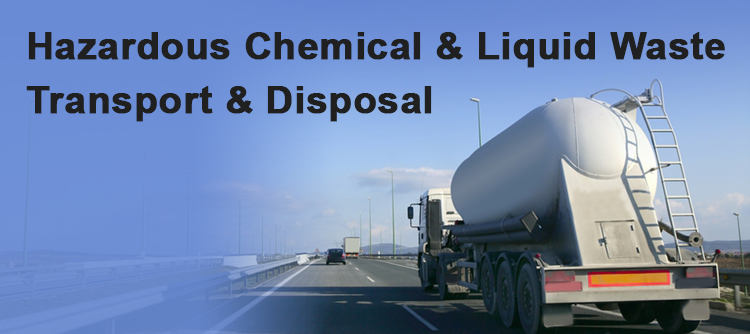Industrial Wastewater Treatment: Advanced Techniques for Effective Administration
Industrial Wastewater Treatment: Advanced Techniques for Effective Administration
Blog Article
How Liquid Garbage Disposal Works: A Comprehensive Introduction of Techniques and Technologies Utilized

Summary of Fluid Waste Kind
The intricacy of liquid waste kinds requires a complete understanding of their attributes and implications for disposal. Liquid waste can extensively be classified into a number of kinds, including industrial, community, agricultural, and dangerous waste. Each group shows distinct residential properties, needing particular administration techniques to reduce environmental and health risks.
Industrial liquid waste stems from making procedures and commonly includes a variety of pollutants, such as hefty steels, solvents, and organic compounds. Community liquid waste, primarily making up wastewater from households and commercial establishments, has natural issue, nutrients, and pathogens (industrial wastewater treatment). Agricultural liquid waste, including drainage from farms, might include fertilizers, pesticides, and animal waste, presenting dangers to water quality and communities
Dangerous liquid waste is identified by its poisoning, reactivity, or potential to trigger damage. Comprehending these diverse fluid waste kinds is crucial for creating efficient disposal methods and making certain compliance with ecological policies.
Physical Therapy Methods

Testing is the first action, where bigger fragments and particles are removed from the fluid waste using screens or grates. This procedure shields downstream equipment from damages and ensures smoother operation. Complying with testing, sedimentation utilizes gravitational force to different solids from liquids. In sedimentation containers, much heavier particles work out near the bottom, creating a sludge layer, while the cleared up fluid can be more dealt with.
Filtration is an additional important approach that involves passing the liquid through porous products, such as sand or membranes, to record smaller particles. This step boosts the high quality of the liquid, making it suitable for subsequent treatment procedures.

Chemical Treatment Methods
Chemical therapy techniques are necessary for successfully managing liquid waste, particularly in addressing liquified and colloidal pollutants that physical approaches might not effectively eliminate. These methods use various chemical agents to neutralize, speed up, or change dangerous materials into much less dangerous types.
One typical technique is coagulation and flocculation, where chemicals such as alum or ferric chloride are contributed to promote the gathering of put on hold bits. This process enhances sedimentation, enabling much easier removal of the resulting sludge. In addition, oxidation processes, utilizing agents like chlorine or ozone, are employed to break down complex organic compounds and pathogens, rendering the waste more secure for discharge or additional treatment.
Neutralization is one more essential strategy, which adjusts the pH of acidic or alkaline waste streams to neutral degrees, avoiding possible injury to downstream systems and the setting. Moreover, progressed oxidation processes (AOPs) make use of combinations of oxidants and ultraviolet light to weaken relentless pollutants, attaining a greater level of therapy effectiveness.
Organic Therapy Processes
Biological therapy procedures play a vital duty in the management of fluid waste by making use of microbes to decompose raw material and lower pollutant degrees. These procedures can be extensively classified into anaerobic and cardio therapies, each employing specific microbial areas to attain effective waste degradation.
Cardiovascular therapy entails the usage of oxygen to promote the break down of organic products by microorganisms. This process is generally applied my sources in activated sludge systems, where aeration containers supply a helpful environment for microbial development, resulting in the oxidation of organic pollutants. The resultant biomass can be separated from treated effluent with sedimentation.
In comparison, anaerobic therapy happens in the absence of oxygen, counting on different germs to break down raw material. This technique is specifically helpful for high-strength waste, as it produces biogas, a renewable resource resource, while reducing sludge manufacturing. Technologies such as anaerobic digesters are frequently used in municipal and commercial applications.
Both cardiovascular and anaerobic organic therapies not only minimize the environmental impact of liquid waste yet likewise facilitate resource recuperation, making them vital parts of lasting waste management techniques. Their performance, performance, and flexibility support their extensive implementation throughout various sectors.
Arising Technologies in Disposal
Ingenious techniques to liquid garbage disposal are rapidly advancing, driven by innovations in innovation and an enhancing emphasis on sustainability. Amongst these arising innovations, membrane layer bioreactors (MBRs) have actually gained traction for their ability to combine biological therapy with membrane filtration, causing high-grade effluent that can be recycled in different applications. MBRs make it possible for smaller sized impacts and much more efficient procedures compared to standard systems.
An additional appealing advancement is making use of anaerobic food digestion incorporated with nutrient recovery innovations, which not just deals with fluid waste however also creates biogas and recoups beneficial nutrients like nitrogen and phosphorus. This twin advantage improves source effectiveness and lowers ecological influence.
Furthermore, progressed oxidation procedures (AOPs) are being adopted for the degradation of intricate natural contaminants. These methods use effective oxidants and catalysts to break down contaminants at the molecular level, offering a very reliable service for difficult waste streams.
Furthermore, the integration of expert system and artificial intelligence in waste management systems is optimizing operational efficiency and predictive upkeep, leading to lowered expenses and boosted environmental compliance. These technologies show a significant shift in the direction of more sustainable and efficient liquid garbage disposal techniques.
Final Thought
In final thought, efficient fluid waste disposal requires an extensive understanding of various methods and modern technologies. By continually progressing these methodologies, it comes to be possible click to deal with the growing difficulties linked with fluid waste, inevitably adding to environmental security and resource recuperation.
Fluid waste disposal is a vital element of environmental management, requiring a comprehensive understanding of different strategies and technologies customized to various waste types. Fluid waste can broadly be classified into several types, consisting of industrial, community, agricultural, and hazardous waste. Agricultural fluid waste, including overflow from farms, might contain fertilizers, pesticides, and animal waste, posturing threats to water find more information top quality and ecological communities.
Various physical treatment approaches play an important duty in handling fluid waste effectively - industrial wastewater treatment.In verdict, effective fluid waste disposal demands an extensive understanding of different methods and innovations
Report this page